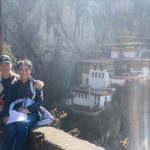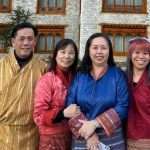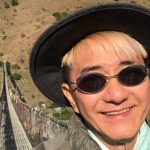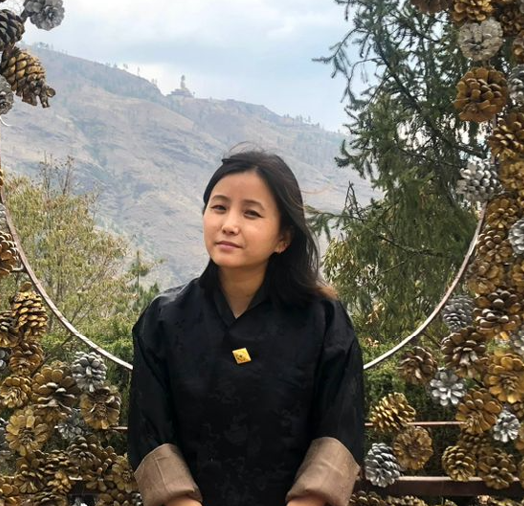Nepal
Trip Overview
- Capital – Kathmandu.
- Area – 147,180 km² (56,826 mi²). Nepal is the 25th smallest country in Asia and 95th in the world.
- Climate – Subtropical, so it is much drier and warmer than in the most parts of the US or Central Europe. Only in a few humid months per year is the intensity of rain a bit higher. Depending on the season, the average daytime temperatures range between 18 and 28 degrees. In some parts of the country, the temperature rises to 30 °C. In the colder months, and depending on the region, the temperature drops to 5 °C on a month’s average.
- Altitude – Average elevation of 3265 m above sea level and is therefore one of the highest countries in the world. The highest mountain peak (Mount Everest) is at 8,848 meters. There is no access to the open sea.
- National Animal – Cow, which is sacred to Hindus.
- National Bird – Himalayan Monal.
- National Flower – Rhododendron Arboreum, also called LaliGurans in Nepali.
- National Language – Nepali.
- National Game – Dandi Biyo.
- National Sport – Volleyball.
- Religion – Hinduism.
- National Dress – DauraSuruwal is the national dress of Nepal.
- A land of discovery and unique experiences, Nepal with its rich ancient cultures, and dramatic sceneries is the destination for individuals who value an experience that is authentic and mesmerizing.
- Home to 8 of the 10 highest mountains in the world, Nepal is a hotspot destination for mountaineers, rock climbers and people seeking adventures. Nepal is one of the last places on earth where you can spot the Asiatic rhinoceros and the Royal Bengal Tiger.
- One of Nepal’s treasure houses is the strong and unique flavors of Nepalese cuisine, apart from the many festivals that people celebrate all year round. with more festivals than days of the year, there is nowhere else in the world that can offer as many festivities as Nepal.
- And one of the best aspects about visiting Nepal is that it is not expensive.
- In a nutshell, Nepal’s major tourist activities include wilderness and adventure activities such as mountain biking, bungee jumping, rock climbing and mountain climbing, trekking, hiking, bird watching, mountain flights, ultralight aircraft flights, paragliding and hot air ballooning over the mountains of the Himalaya, hiking and mountain biking, exploring the waterways by raft, kayak or canoe and jungle safaris, especially in the Terai region.
Detailed Descriptions
Culture
- Culture tourism involves travel to experience and learn about the culture of a country or region. It includes tangible and intangible features of a destination’s history and heritage, culture, lifestyle, art, architecture and religion that have shaped the society’s way of life. One of the largest tourism niches in the world today, there are many reasons why developing authentic, unique and immersive cultural tourism products are beneficial to destinations at national, regional and local levels. And you will find all the above and more in Nepal, reflected in the country’s architecture, food, festivals and way of life.
Art and Architecture
- Nepal’s architectural heritage is an important part of its cultural identity, showcasing excellent craftsmanship and divided into three main styles. The influence of Hinduism and Buddhism is reflected in its temples, chaityas, and art. The Pagoda style, introduced in the 13th century, features multiple roofs that gradually narrow at the top, seen in examples such as Changu Narayan and Kailashkut Bhawan. The Stupa or Chaitya style, with a broad base tapering upwards, was brought to Nepal by Emperor Ashok and can be seen in the Maya Devi temple and Swayambhunath. The Shikhar style is tall and pyramid-like with several sections and is exemplified by Krishna Mandir and Mahaboudha.
Religious sites
- Nepal is a diverse country with multiple religions practiced. The primary religion followed in Nepal is Hinduism, and many people travel to the Pashupatinath Temple, located in Kathmandu, which is one of the world’s most important Hindu pilgrimage sites. Other significant Hindu pilgrimage sites include the temple complex in Swargadwari, Lake Gosainkunda, temples at Devghat, Manakamana temple, and Pathibhara. Buddhism is also a prevalent religion, and Lumbini, the birthplace of Gautama Buddha, is a renowned pilgrimage site. Swayambhunath, also known as the Monkey Temple, in Kathmandu, is another important Buddhist site. The Dang valley is a sacred place for both Hindus and followers of other religions, and there are many significant places such as Kalika and Malika Devi in Chhillikot hill, Ambekeshawori temple, Krishna temple, Dharapani temple, and an ancient palace of a king. Muktinath Valley in the Mustang district is considered a holy place for both Hindus and Buddhists.
Festivals
- Nepal has a diverse culture with various festivals that showcase its colorful traditions. Many festivals have religious significance, and some are based on ancient mythology and literature. The major festivals, Dashain and Tihar, are celebrated by everyone, regardless of their beliefs. Buddha Jayanti, GaiJatra, JanaiPurnima, Teej, and Mahashivaratri are other significant festivals celebrated in Nepal. Each festival has its unique customs, such as wearing red sarees, renewing holy threads, and parading as cows. The Pashupatinath temple is the most popular destination for devotees during Mahashivaratri.
Dance and music
- According to legends, dances in the Indian subcontinent are said to have originated in the Himalayas and the Himalayan Kingdom of Nepal, where Lord Shiva performed the tandava dance. This suggests that Nepal’s dances are very ancient. Over time, with differences in altitude and ethnicity, dance styles and costumes have evolved. For example, the Dishka dance, performed at weddings, involves intricate footwork and arm movements. The accompanying music and instruments vary according to the themes, which include topics such as crop harvesting, wedding rituals, war stories, the longing of a lonely girl for her love, and other everyday life themes from villages.
Flora
- Nepal has 2.8% of the world’s total plant species, including 2.36% of the global flowering plants, with 6391 flowering plants found in the country. The protected sites of Nepal have 2532 vascular plant species, including 130 endemic species. The lower Terai region hosts Sal, Simal, and Asna, while the middle hilly regions have oak, pine, and bamboo, and the upper Himalayas have Rhododendron woodland, pine, fir, and birch. Himalayan plants have medicinal value and are widely used in traditional Ayurvedic, Homeopathic, and Amchietc practices, and even allopathic medicines. Some commonly known herbs include Aloe Vera, Asparagus, and Neem, but there are many other medicinal herbs found in Nepal.
Fauna
- Nepal is home to a diverse range of fauna, with rare species making up a significant portion of its population. Mammals, butterflies, and birds all contribute to this diversity, with 185 mammal species found across Nepal’s Lower-Terai to Upper-Himalayas regions. The Asiatic Elephant, one-horned Rhinoceros, and Royal Bengal Tiger reign supreme in the tropical jungles of the Terai, while other animals such as monkeys, leopards, and deer also call this region home. The rivers of Karnali and Narayani are home to a unique variety of Ganges dolphins, although sightings have become rare due to devastating floods. The Himalayan region is home to elusive species such as the snow leopard and red panda, as well as commonly seen animals such as the Yak and Blue Sheep. Dhorpatan forest is the only hunting reserve in Nepal where hunting of Himalayan Tahr and Blue Sheep is permitted.
Birds
- Nepal is home to a variety of bird species, with 850 recorded species. The Spiny babbler, once thought to be extinct, was rediscovered flying over the hills of Phulchowki. Many bird species can be seen around the Kathmandu valley, with Nagarjuna, Godavari, and Phulchowki being popular spots for bird watchers. National Parks, such as the Koshi-Tappu wildlife reserve, offer a chance to see a wide range of bird species, including Watercock, Indian Nightjar, and Pallas’s fish eagle. In the Himalayas, birds like Impeyan Pheasant, Cheer Pheasant, and Satyr Tragopan soar over the snow-capped peaks, making Nepal a vibrant birding region.
Food
- In Nepal, there are plenty of restaurants and hotels where one can find any cuisine they desire. However, Nepalese dishes are some of the most delicious, from the simple Dal Bhat to the popular Momos. Dal Bhat is a traditional meal of rice and lentils served with side dishes such as meat, vegetables, curd, and pickles. NewariKhaja and Yomari are ethnic foods of the Newar community, while chatamari is a rice flour dish with vegetable or meat toppings. Momos, or dumplings, are a favorite cuisine in Nepal.
Mountain Climbing
- The 800 km stretch of the Nepal Himalayan is the greatest in the world with eight peaks that rise above 8,000m including the highest in the world, Mt. Everest. Ever since the country opened its peaks to climbers in 1994, the Nepal Himalayan has become a great theatre of mountaineering activity and the drama of success and failure have provided impetus to thousands of men and women to meet the ultimate challenge. The Nepal Himalayan has been an attraction to many people, be they saints, philosophers, researchers or adventures.
Trekking
- The best way to experience Nepal’s unbeatable combination of natural beauty and culture riches is to walk through them. One can walk along the beaten trails or virgin tracks. Either way you are in for an experience for a lifetime. Along with forests of rhododendron, isolated hamlets, and small mountain villages, birds, animals, temple, monasteries and breathtaking landscapes, you will also encounter friendly people of different cultures offering a fascinating glimpse of traditional rural life.
Frequently Asked Questions
- Best time to visit Nepal?
Answer: Nepal has a diverse range of elevations and climates, which can cause weather variations between regions, making it difficult to make general statements about seasonal weather. However, spring and fall are popular for trekking due to stable weather and clear skies, while winter and summer have unique advantages and fewer crowds. Winter is good for trekking in lower elevations and visiting the jungles of Chitwan and Bardia, while summer is best for visiting the “rain shadow” areas of Upper Mustang and Nar Phu.
- What’s the difference between private and group trips?
Answer: Private trips are tailor-made itineraries built around your travel dates and personal interests, whereas group trips (which is what most tour companies offer) are pre-packaged and depart on specific dates. Group trips are also open for others to join, whereas private trips are just for you.
- How do I get my visa for Nepal?
Answer: For most nationalities, you can get your visa on arrival in Kathmandu. It takes around 45 minutes and is the most convenient way to get your visa. You can also apply for a visa in advance from a local Nepali consulate in your country if you’d like to have everything arranged in advance.
- How difficult are the treks?
Answer: Classifying the difficulty of a trek is somewhat tricky, as it depends on your fitness and experience hiking in the mountains. In the Himalaya, a trek’s difficulty depends on the steepness of the trail, the general altitude, and the duration of the trek. Generally, the higher you go the more difficult the trek becomes. For most treks in the lower foothills (Ghorepani, Ghandruk, and Pikey Peak), it’s fairly moderate trekking, although some days will be more challenging than others. For higher-altitude treks (Everest Base Camp, Gokyo, Annapurna Circuit and Nar Phu), the treks become more challenging as you’ll be going over 5,000m passes and longer days.
- How many days should I spend in Nepal?
Answer: If you’re mainly looking to experience Nepal’s cultural and natural highlights, you can have a great experience in 5-7 days, where you can visit two regions (likely, Pokhara and Kathmandu). To get into the Himalaya on a multi-day trek, you’ll want at least 10 days to have enough time to reach higher altitudes and safely acclimatize. To undertake one of the longer, classic treks in Nepal or to combine multiple regions and activities into one visit, 14-20 days is ideal.
- How much luggage can I take on domestic flights?
Answer: For mountain flights, you’re allowed 5 kg. for carry-on and 10 kg. for checked-in luggage. For non-mountain sector flights, the check-in allowance increases to 20-25 kg.
- What date does the trek start?
Answer: Your trek starts on the date that works best for you, given all of the tours our specialists organize are tailored to your travel dates. Typically, you need at least 1-2 days in Kathmandu prior to your trek in order for your specialist to organize the necessary trekking permits.
- What happens if I fall ill during the trek?
Answer: If you fall ill during your trek, the course of action depends on what’s wrong. If it’s altitude sickness, moving to lower altitudes and taking altitude medication will solve most cases; if it’s quite severe, your guide will arrange for an emergency evacuation by helicopter (be sure that emergency helicopter rescue is covered in your travel insurance). If you have a stomach sickness or other types of food or water-related illnesses, your guide will have medication on-hand for most common illnesses.
- Where can I store my luggage during the trek?
Answer: You can leave your additional luggage at your hotel in Kathmandu or at the company office of your specialist. Either way, your luggage will be waiting for you at your hotel when you return back from your trek.
Trip Review
Tour guide Pema Letho made the Bhutan trip both informative and entertaining. He always has some interesting stories to...

Mei Wu
It was truly an eye-opening visit to Bhutan, and we had a really enjoyable experience! The 7D6N itinerary was...

ww weiting
We had a very good experience for our first visit to Bhutan. The itinerary was very complete and our...

Jamie Tan
Great sights, great food, great iternary, awesome guide. A totally unexpected enjoyable experience in Bhutan.

Laura Lim
My trip to Bhutan was a great experience for me. Amazing country with a lot of fresh air; people...

Marie
I just returned from a 7-day tour of Bhutan and had the privilege of Guide Dago Tshering and driver...

Adrian Loo
Trip Facts
Districts Kathmandu
Venue Kathmandu
Accomodation Hotel or Resort
Max. Altitude 3265

 Districts Kathmandu
Districts Kathmandu Accomodation Hotel or Resort
Accomodation Hotel or Resort Max. Altitude 3265
Max. Altitude 3265






